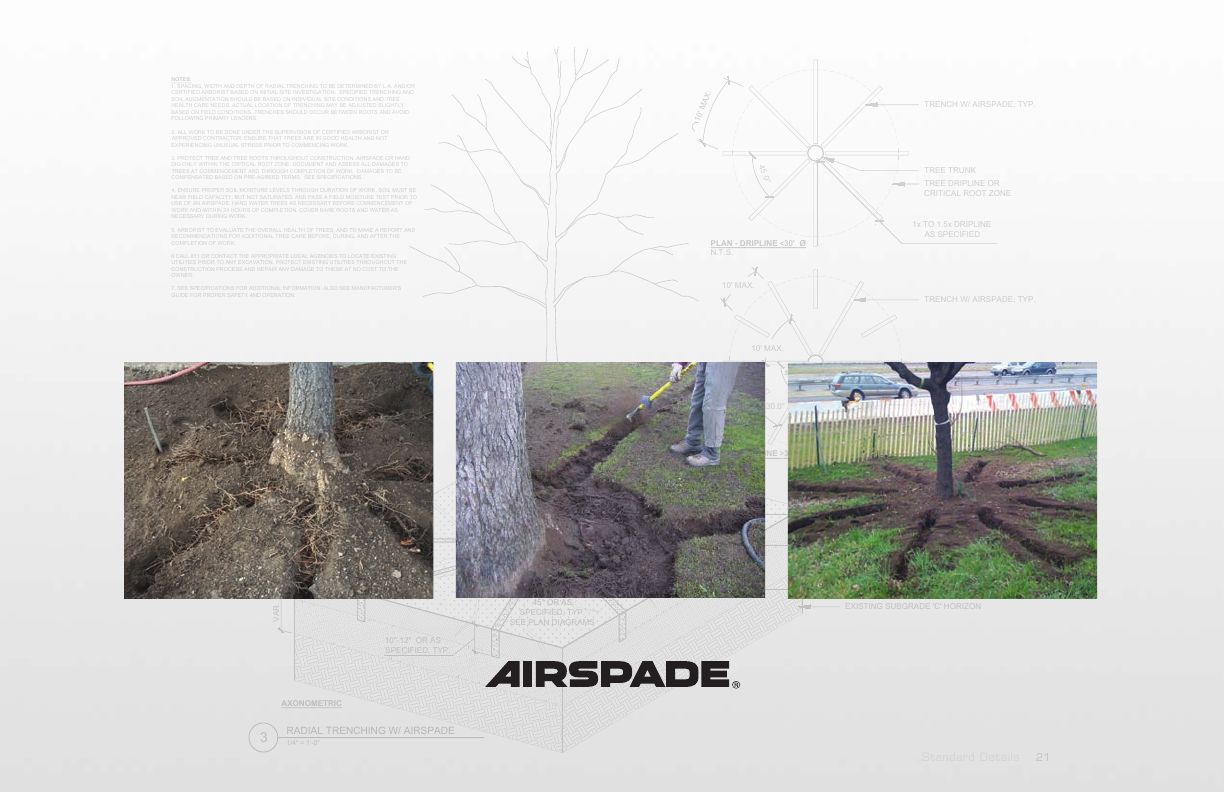Specification Sheet

Standard Details 21
RADIAL TRENCHING W/ AIRSPADE
1/4" = 1'-0"
3
45° OR AS
SPECIFIED, TYP.
SEE PLAN DIAGRAMS
EXISTING SUBGRADE 'C' HORIZON
10' MAX.
PLAN - DRIPLINE
<
30'
Ø
N.T.S.
PLAN - DRIPLINE
>
30' Ø
N.T.S.
10' MAX.
10' MAX.
±60.0°
±30.0°
45.0°
AXONOMETRIC
TRENCH W/ AIRSPADE, AVOID MAJOR ROOT
LEADERS, REMOVE EXISTING SOIL AND REPLACE
WITH SPECIFIED SOIL OR BLENDED
SOIL AUGMENTATION, TYP.
EXISTING TOPSOIL 'A' HORIZON
TRENCH W/ AIRSPADE, TYP.
TRENCH W/ AIRSPADE, TYP.
TREE TRUNK
TREE DRIPLINE OR
CRITICAL ROOT ZONE
1x TO 1.5x DRIPLINE
AS SPECIFIED
TREE TRUNK
1x TO 1.5x DRIPLINE
AS SPECIFIED
NOTES:
1. SPACING, WIDTH AND DEPTH OF RADIAL TRENCHING TO BE DETERMINED BY L.A. AND/OR
CERTIFIED ARBORIST BASED ON INITIAL SITE INVESTIGATION. SPECIFIED TRENCHING AND
SOIL AUGMENTATION SHOULD BE BASED ON INDIVIDUAL SITE CONDITIONS AND TREE
HEALTH CARE NEEDS. ACTUAL LOCATION OF TRENCHING MAY BE ADJUSTED SLIGHTLY
BASED ON FIELD CONDITIONS. TRENCHES SHOULD OCCUR BETWEEN ROOTS AND AVOID
FOLLOWING PRIMARY LEADERS.
2. ALL WORK TO BE DONE UNDER THE SUPERVISION OF CERTIFIED ARBORIST OR
APPROVED CONTRACTOR. ENSURE THAT TREES ARE IN GOOD HEALTH AND NOT
EXPERIENCING UNUSUAL STRESS PRIOR TO COMMENCING WORK.
3. PROTECT TREE AND TREE ROOTS THROUGHOUT CONSTRUCTION. AIRSPADE OR HAND
DIG ONLY WITHIN THE CRITICAL ROOT ZONE. DOCUMENT AND ASSESS ALL DAMAGES TO
TREES AT COMMENCEMENT AND THROUGH COMPLETION OF WORK. DAMAGES TO BE
COMPENSATED BASED ON PRE-AGREED TERMS. SEE SPECIFICATIONS.
4. ENSURE PROPER SOIL MOISTURE LEVELS THROUGH DURATION OF WORK. SOIL MUST BE
NEAR FIELD CAPACITY, BUT NOT SATURATED, AND PASS A FIELD MOISTURE TEST PRIOR TO
USE OF AN AIRSPADE. HAND WATER TREES AS NECESSARY BEFORE COMMENCEMENT OF
WORK AND WITHIN 24 HOURS OF COMPLETION. COVER BARE ROOTS AND WATER AS
NECESSARY DURING WORK.
5. ARBORIST TO EVALUATE THE OVERALL HEALTH OF TREES, AND TO MAKE A REPORT AND
RECOMMENDATIONS FOR ADDITIONAL TREE CARE BEFORE, DURING, AND AFTER THE
COMPLETION OF WORK.
6 CALL 811 OR CONTACT THE APPROPRIATE LOCAL AGENCIES TO LOCATE EXISTING
UTILITIES PRIOR TO ANY EXCAVATION. PROTECT EXISTING UTILITIES THROUGHOUT THE
CONSTRUCTION PROCESS AND REPAIR ANY DAMAGE TO THESE AT NO COST TO THE
OWNER.
7. SEE SPECIFICATIONS FOR ADDITIONAL INFORMATION. ALSO SEE MANUFACTURER'S
GUIDE FOR PROPER SAFETY AND OPERATION.
SOIL 'B' HORIZON
10"-12" OR AS
SPECIFIED, TYP.
4" TYP.
TREE DRIPLINE OR
CRITICAL ROOT ZONE
VAR.VAR.
EXISTING TREE ROOTS, TYP.
Download your FREE
Technical Applications Guide
Learn the ins and outs of utilizing an AirSpade for a variety of arbor applications.
Visit airspade.com/guide
20 AirSpade Technical Applications Bulletin
several years to make more extensive improvements to a tree’s soil.
Radial trenching is preferably done throughout the dripline or beyond.
Once the removal of turf and plant material is complete and the trench
pattern is laid out (it may be helpful to paint guides on the ground), the
operator can begin excavation. The operator will continuously move the
AirSpade while holding the tool at a 30° to 45° angle to achieve the
specified depth and working side to side to control the trench width.
While digging a trench, plywood sheets are recommended to cover
adjacent trenches to prevent refilling. The soil can then be collected to
be replaced or amended, or it may be augmented in place. An AirSpade
can be used in the soil replacement process to help blend the new and
existing soil, and to fill pockets around tree roots.
Linear trenching is a variation of radial trenching in which an area
is trenched in parallel rows rather than in a radial pattern. This is
useful for working in planted beds or in areas with trees planted
closely together. Another technique similar to radial trenching is called
root trenching, in which select primary root leaders are deliberately
uncovered rather than avoided. Root trenching is often used to train
roots deep into the soil, under a paved surface, and into adjacent
planting soils or to install a root barrier.
Radial trenching with AirSpade is done to modify soil composition,
improve aeration, and encourage root growth to moderate depths
(typically 10”-12” or more), and is especially effective when trees have
highly stratified or shallow depth of viable soil or anaerobic conditions.
Additionally, this application can be useful in planting areas where
minimal disturbance is desired.
Radial trenching is shown to encourage deep root growth far reaching
from the trunk and between structural root leaders. An appropriate
soil augmentation strategy is vital to each individual project. Because
radial trenching is not as uniform as air tilling for soil augmentation,
it can produce undesirable concentrations of nutrients if not properly
considered. It’s therefore important to carefully select amendments
that are compatible with existing soils, and it can be beneficial to
perform air tilling in combination with radial trenching. For example, it
may be preferable to augment soil within radial trenches with a higher
percentage of porous inorganic materials (such as sand) to improve
aeration and to then amend the top soil with a higher percentage of
organic nutrients using the more uniform air tilling (or root invigoration)
procedure. Alternatively, established trees that are struggling to
survive in poor soils may benefit from a long-term strategy in which
radial trenching is performed several times and over the course of
Radial Trenching
Radial trenching was combined with root collar excavation
around this street tree to prune girdling roots and
encourage deeper root growth.
Radial trenching with an AirSpade encourages root growth
by breaking through compacted and highly stratified soil
layers.
Once air-spaded, radial trenches can be filled with new or
augmented soil.
Division of Guardair Corporation
47 Veterans Drive • Chicopee, MA 01022-1062
Toll-Free: 800-482-7324 | Local: 413-594-4400 | Fax: 413-594-4884
Email: info@airspade.com • airspade.com










